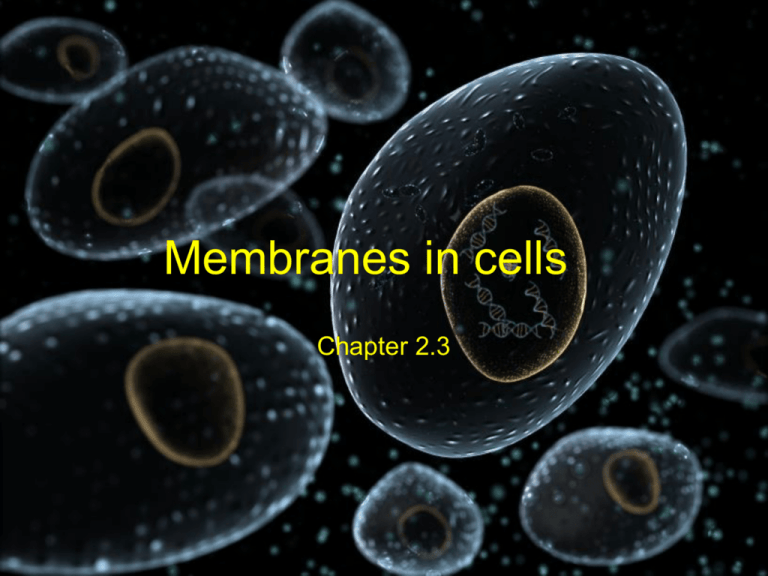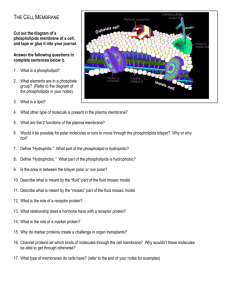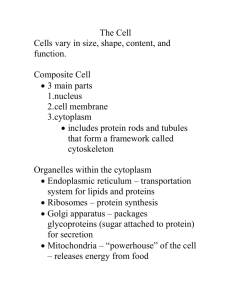1.5 AS Cell Membranes
advertisement

Membranes in cells Chapter 2.3 Objectives of unit: • Understand the structure and properties of the plasma membrane • Explain passive transport mechanisms of diffusion and facilitative diffusion, including the role of transporter and carrier proteins • Define the process of osmosis • Explain the process of active transport and the role of proteins and ATP • Explain the processes of endocytosis and exocytosis • Describe the properties of gas exchange surfaces in living organisms • Explain how the structure of the mammalian lung is adapted for rapid gaseous exchange Cells have many membranes: plasma membrane tonoplast outer mitochondrial membrane inner mitochondrial membrane outer chloroplast membrane nuclear envelope Membranes are flexible and able to break and fuse easily Membranes allow cellular compartments to have different conditions pH 4.8 Contains digestive enzymes, optimum pH 4.5 - 4.8 lysosome Membrane acts as a barrier pH 7.2 cytosol Membranes are mainly made of phospholipids phosphate group hydrophilic head phosphoester bond glycerol ester bond fatty acid hydrophobic tail The polar hydrophilic heads are water soluble and the hydrophobic heads are water insoluble Hydrophobic (water-hating) tail air aqueous solution Hydrophilic (water-loving) head Phospholipids form micelles when submerged in water In 1925 Gorter and Grendel proposed that the unit membrane is formed from a phospholipid bilayer Extracellular space (aqueous) Phosphate heads face aqueous solution phospholipid bilayer Cytosoplasm (aqueous) Hydrophobic tails face inwards Initial studies showed that the plasma membrane had layers: Scientists also found that protein were present in membranes so Davson-Danielli proposed in 1935 the following model for membrane structure: Protein Phospholipid bilayer The development and use of electron microscopes showed that the Davson-Danielli model was incorrect In the early 1970s Singer and Nicholson used techniques such as freeze-etching to confirm the lipid bilayer. They also showed that the proteins were distributed throughout the protein in a mosaic pattern. In addition they found that the membrane was fluid and had considerable sideways movement of molecules within it. Hence they proposed the Fluid-Mosaic Model for Plasma Membrane Structure. The fluid mosaic model of the plasma membrane: The proteins can move freely through the lipid bilayer. The ease with which they do this is dependent on the number of phospholipids with unsaturated fatty acids in the phospholipids. Fat-soluble organic molecules can diffuse through the bilayer but polar molecules require proteins Fat-soluble molecules Polar molecules Extracellular space Cytosoplasm (aqueous) hydrophilic pore Osmosis •Water is a polar molecule •Water must pass through a protein to enter or leave the cell •The movement of water is OSMOSIS •Osmosis is the movement of water from an area of less negative water potential to an area of more negative water potential through a partially permeable membrane. OSMOSIS IN PLANT CELLS The membrane contains many types of protein: carbohydrate chain Glycocalyx: For cell recognition so cells group together to form tissues Receptor: for recognition by hormones glycoprotein peripheral protein Enzyme or signalling protein integral protein carrier protein hydrophilic channel Question: Label the diagram (11marks) 4 1 5 6 Note: label the proteins based on location or structure, e.g. you do not need to identify receptors and enzymes. 3 2 7 10 9 11 8 1) carbohydrate; 2) glycoprotein; 3)integral protein; 4) peripheral protein; 5) carrier protein 6) hydrophilic channel; 7)Click phosphate group; 8) fatty acid; 9) phospholipid; to reveal answers 10) glycocalyx; 11) phospholipid bilayer click to cover answers There are different types of carrier proteins in the membrane: ATP Carrier protein (passive) Gated-channel protein Channel protein Carrier protein (active) Facilitated Diffusion • Facilitated Diffusion occurs through a carrier protein • Polar molecules move from an area of high conc. to an area of low conc. • No ATP is required Active Transport • Active transport occurs through a carrier protein • Polar molecules move from a low to a high concentration • ATP energy is required Membrane bound proteins allow chemical processes to occur on membranes in a sequential manner: proteins membrane Cyt c Q I III II Enzyme and transporter proteins involved in aerobic respiration in the inner mitochondrial membrane IV ATP synthase Summary • The unit membrane consists of a phospholipid bilayer • Phospholipids consist of a polar, hydrophilic phosphate head and a nonpolar, hydrophobic tail consisting of fatty acid chains. • Proteins also occur in the membrane and float freely throughout it. • The model for membrane structure is known as the fluid mosaic model. • Peripheral proteins occur on the inner or outer face of the membrane and integral proteins extend through both lipid layers. • Membrane bound enzymes occur allowing structured metabolic pathways. • Glycoproteins form the glycocalyx and allow cell to cell recognition. • Receptor proteins can act as binding sites for hormones and other substances and can transmit the information to the interior of the cell. • A variety of carrier proteins allow for the controlled movement of substance through the membrane using both passive diffusion or active transport. • Non-polar, lipid soluble molecules diffuse through the phospholipid bilayer. • Ionic, polar molecules require carrier proteins to enable them to pass through the membrane. • Membrane structure loses integrity with high temperature or presence of organic solvents such as alcohol, thereby increasing permeability.








